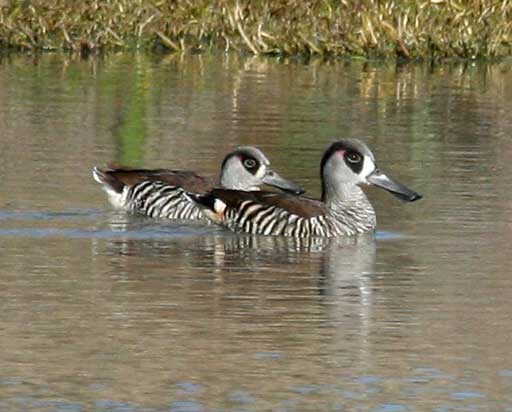Malacorhynchus membranaceus (*) Cladus: Eukaryota Name Malacorhynchus membranaceus (Latham, 1802) References * Supplementum indicis ornithologici sive systematis ornithologiae. p.lxix Vernacular names
The Pink-eared Duck (Malacorhynchus membranaceus) is a species of duck found in Australia. It has a large spatulate bill like the Australasian Shoveler, but is smaller at 38–40 cm length. Its brown back and crown, black and white barred sides and black eye patches on its otherwise white face make this bird unmistakable. Juveniles are slightly duller, but otherwise all plumages are similar. Its vernacular name refers to a pink spot in the corner formed by the black head pattern; it is only noticeable at close distance however, making the seldom-used Australian name of Zebra Duck more appropriate.
It is the only living member of the genus Malacorhynchus; a closely related, but slightly larger extinct form from New Zealand was described as Scarlett's Duck (Malacorhynchus scarletti). This peculiar duck may be most closely related to the shelducks but its relationships are enigmatic. It may be closer to the Musk Duck and the stiff-tails (Sraml et al. 1996) and, formerly placed in the paraphyletic "perching ducks" it is in any case not close to the dabbling ducks. The Pink-eared Duck was reportedly known as the New Holland Duck by early colonists in Western Australia. Distribution Widely distributed throughout Australia and highly mobile, these ducks can appear anywhere there is standing water, especially in dry inland regions, where annual rainfall rarely exceeds 15 inches. Food
Breeding Nesting is stimulated by the drying and filling of pools that promote increased levels of organic material. In good years, large numbers of Pink-eared ducks concentrate in shallow flood plains. However, when conditions do not meet specifications, reproduction may be completely curtailed. References BirdLife International (2004). Malacorhynchus membranaceus. 2006. IUCN Red List of Threatened Species. IUCN 2006. www.iucnredlist.org. Retrieved on 11 May 2006. Database entry includes justification for why this species is of least concern Source: Qikipedia, Wikispecies: All text is available under the terms of the GNU Free Documentation License |
|

